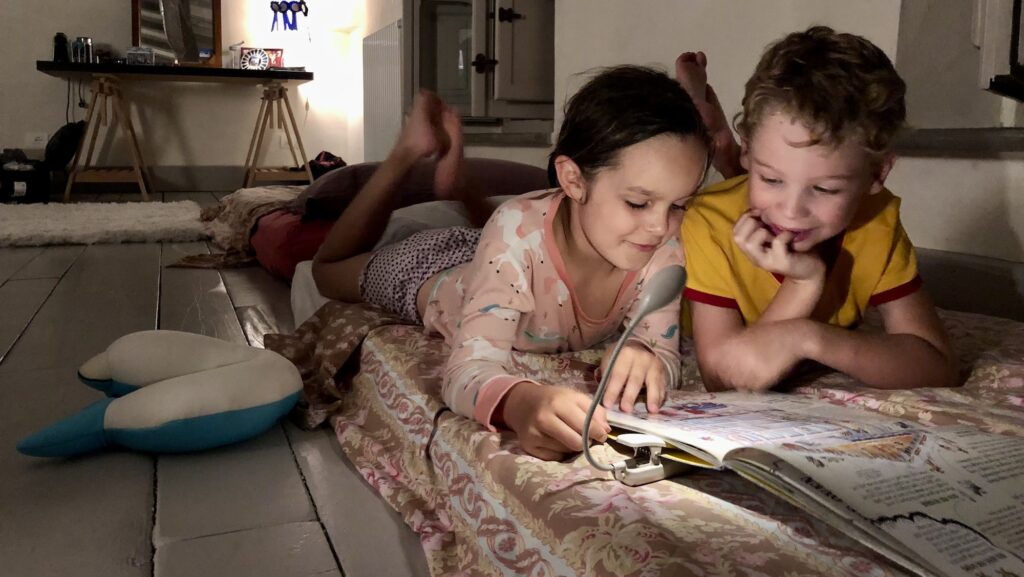Jet lag is a reality of travel, and when you’re traveling with kids, the stakes feel even higher. Knowing how to help kids (and adults) combat jet lag is a key part of a great family vacation.
When my kids were five and seven, my sister-in-law moved to Singapore. Planning our first visit felt exciting, but I was also hesitant because of the long flight, 16-hour time difference, and the serious jet lag I knew we’d all face. And while the adjustment was rough, we got through it and had a great time.
The lessons I learned on that trip have given my family a foundation that helps us all—adults and kids—get through jet lag more quickly, adjust our circadian rhythms, and enjoy our family travel adventures.
Though there’s no magic formula to erase jet lag, there are things you can do to ease your family members into a new time zone. Here are the seven steps I follow to mitigate jet lag, manage travel fatigue, and enjoy visiting our favorite family vacation spots.
PLAN AHEAD: 8 Cheap Spring Break Trips That Don’t Skimp on the Fun
Preparing for Jet Lag Before Your Trip

Proper planning prevents poor performance. Jag lag will happen—that’s just the reality. So my family has created this plan to combat it even before we leave the house.
1. Understand the Time Difference
It’s useful to anticipate how your body will feel in the new time zone. To do this, calculate what time wake-up, midday, and bedtime will be in the traveling country compared to your time zone. Armed with the information about the number of time zones you’ll be bridging, you can predict jet lag symptoms such as early wake-ups, difficulty falling/staying asleep, and general cranky times. Understanding how your family will feel in the new time zone will help you work with jet lag rather than fight jet lag.
MAKE MEMORIES: 27 Family Vacation Ideas for a Trip They’ll Never Forget
My family went to Barcelona (an eight-hour time difference) when our kids were nine and seven. That meant that 8:00 a.m. felt like 11:00 p.m. and 8:00 p.m. felt like 11:00 a.m. Instead of fighting to be on an 8:00 to 8:00 schedule like we generally are at home, we embraced an 11:00 p.m. to 10:00 a.m. routine. This worked perfectly for a European city vacation since activities don’t start early and dinnertime in Europe is generally 8:00 p.m. or later.
2. Create a Plan that Fits Your Family’s Style
Once you’ve got a handle on the time difference, you can create an itinerary for the first two days with the symptoms of jet lag in mind. Having a pre-set itinerary will let you be on autopilot, because you will be jet lagged too. There are two basic approaches:
- Take it Easy: Fill the day with low-key activities like going to a beach or a picnic in the park. Keep the plans loose and avoid doing lots of things that involve timed tickets or reservations. This approach is great for families who don’t usually follow a schedule.
- Action-Packed: Start right away with super exciting and action-packed days. Fight jet lag with action. Fill the day with lots of activities and keep everyone moving. This approach is great for families who thrive with routines and structure.
Choose the approach that will best work for your family, then plan your first few days accordingly. Whichever style you choose, make sure to opt for activities that will keep a sleepy child engaged and busy.
ROLL WITH IT: 10 Kids Luggage Brands to Make Family Travel Easier
For maximum buy-in, enlist your kids to help with the itinerary. Have each child pick three things they really want to do, then weave a few of their top activities into the first two days. Having something they want to do will motivate them to fight jet lag.
3. Make a Plan for When Jet Lag Strikes
At some point, everyone will feel jet lagged, so it’s important to have a plan to manage common jet lag symptoms.
When it’s bedtime and jet lag is winning, fight back by keeping the lights low and staying in bed. Let kids know that “bedtime” is the time they have to stay in bed. You cannot force sleep, but you can insist that they stay in bed during bedtime. This is really important for two reasons. One, staying in bed helps the body learn the new sleep time and, two, it’s better for everyone if awake family members let sleeping members sleep. For really young children, they can lie in their parents’ bed when awake at night.
VACATION READS: 33 Books Like Harry Potter to Binge on Your Next Vacation
Pro Tip: Give children a reading light to clip onto a book so they can read in bed. For really young children, bring them into your bed with a light. Give them board books and a stuffy to play with quietly. If your child is not independent, assign one parent to read with them in bed so the other one can sleep. And then trade off.
Have downtime activity for daytime jet lag. Have each family member brainstorm a few activities they can do when they are tired. Unless naps are part of your home routine, it’s better to avoid napping, since sleeping during the day will extend jet lag symptoms. Relax-time activities should be portable because jet lag can strike at any time. Some easy sleepy activities include reading, drawing or coloring books, playing with little toys (hot wheels or a stuffy), and listening to audiobooks.
FIND A DEAL: 12 Best Hotel Booking Sites for Cheap Prices
My kids really enjoy audiobooks, so we always download a bunch before our trips and keep headphones with us. When my kids were six and eight we went to Paris (a nine-hour difference). On our first full day there, we were in a museum when the jet lag sleepiness hit my oldest daughter. We put on an audiobook and she followed us around while listening to a story. While she missed the museum, she did not prevent the rest of the family from enjoying the experience.
4. Prepare Your Body
Take the extra steps to be well-rested for the trip. Some experts suggest shifting your sleep schedule slowly to match the new time zone. I find this unrealistic because school and work hours cannot be changed, and there’s usually a lot going on before a trip. Also, especially with younger children, moving bedtime later does not always yield a later wake up. In my opinion, it’s much better to stick to your regular routine and be well rested.
CRUISE DEALS: Kids Sail Free on These 7 Cruise Lines
Combatting Jet Lag When You Arrive

There are plenty of things you can do to help your body fight jet lag once you arrive at your destination. Here are some of my favorite tips.
5. Get Plenty of Sun
The sun helps your body’s internal clock adjust to the new time and fight the symptoms of jet lag. So on your first few days in a new place, make sure to be outside in the bright light as much as possible to soak up the sunlight. That natural light exposure will make a big difference in how you feel. (Now is the time to look back at your first-two-days itinerary and make sure there’s plenty of outside time built in.)
EAT WELL: 7 All-Inclusive Resorts with the Best Food
6. Eat at the Right Times and Stay Hydrated
Eating at the meal times in your destination helps your body understand the new time zone. Even if you are tired and not hungry during mealtime, you should still try to eat, at least a little. Dehydration exacerbates jet lag symptoms, and long flights are particularly dehydrating. Sport drinks or hydration tablets—especially in the beginning of the trip—help you stay hydrated and ease jet lag symptoms.
Pro Tip: You can make eating at the right time fun for kids. My youngest daughter was six when we went to Paris. She is a terrible morning person and hates eating breakfast. I anticipated it being worse in Paris because 9:00 a.m. in Paris is midnight in California. Leading up to the trip, we talked about the time difference and focused on difficult wake ups. Each morning in Paris, I woke her up by saying it was time for a midnight snack. She woke up with a smile instead of a groan and looked forward to her “midnight snack” breakfast.
FUN FOR ALL: 11 All-Inclusive Resorts with Kids Clubs That Go Above and Beyond
7. Sleep at the Right Time and Consider Melatonin
Falling asleep when your body thinks it’s not bedtime can be a challenge for kids and adults alike. Some families like to take melatonin—this is a personal family decision. Melatonin is not a sleeping pill, but it helps your body regulate sleep cycles. It is taken up to an hour before bedtime and comes in child and adult doses (often in a gummy form for kids).
More from FamilyVacationist:
- 6 Best Hawaii All-Inclusive Resorts for Families
- 11 Budget Family Vacations That Are Actually Super Fun
- 28 Best Places to Visit with Kids This Year













